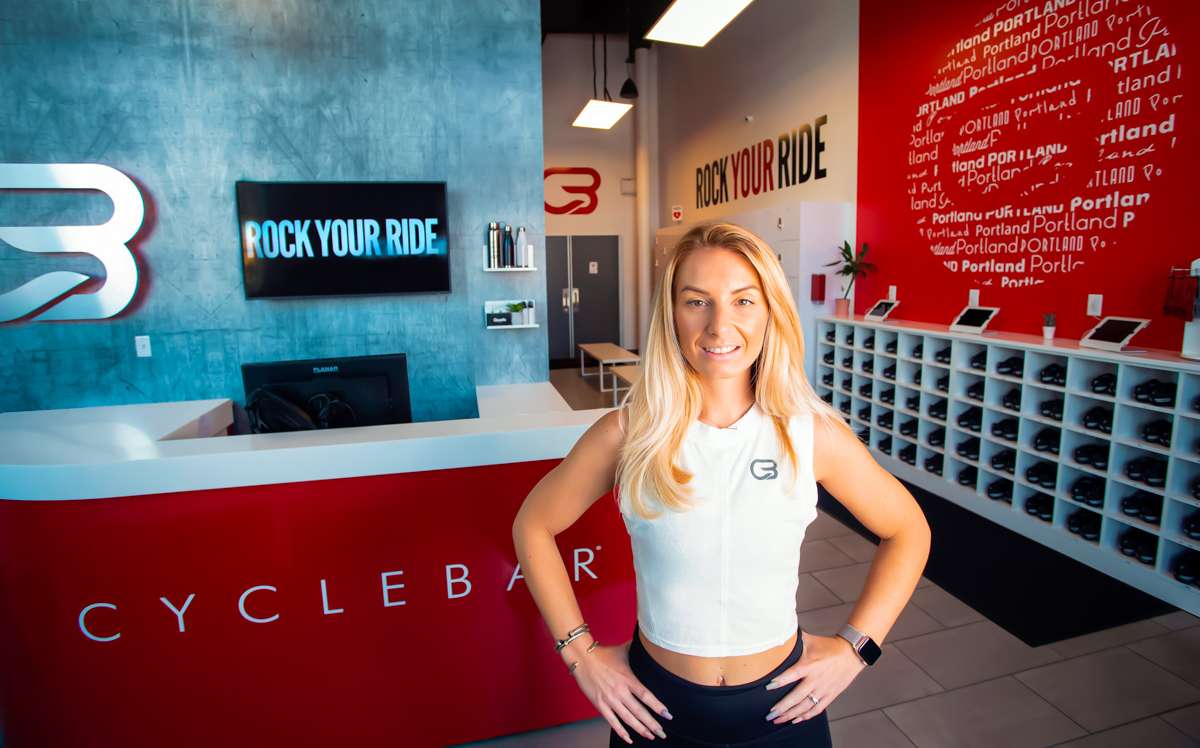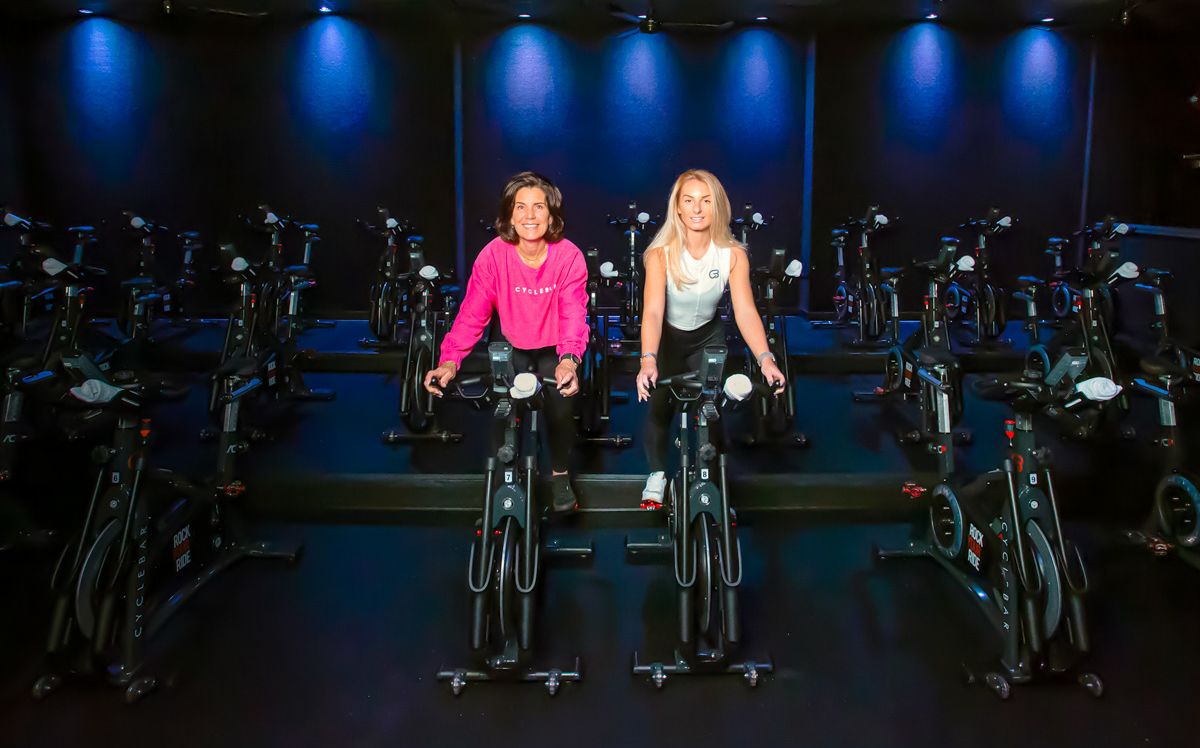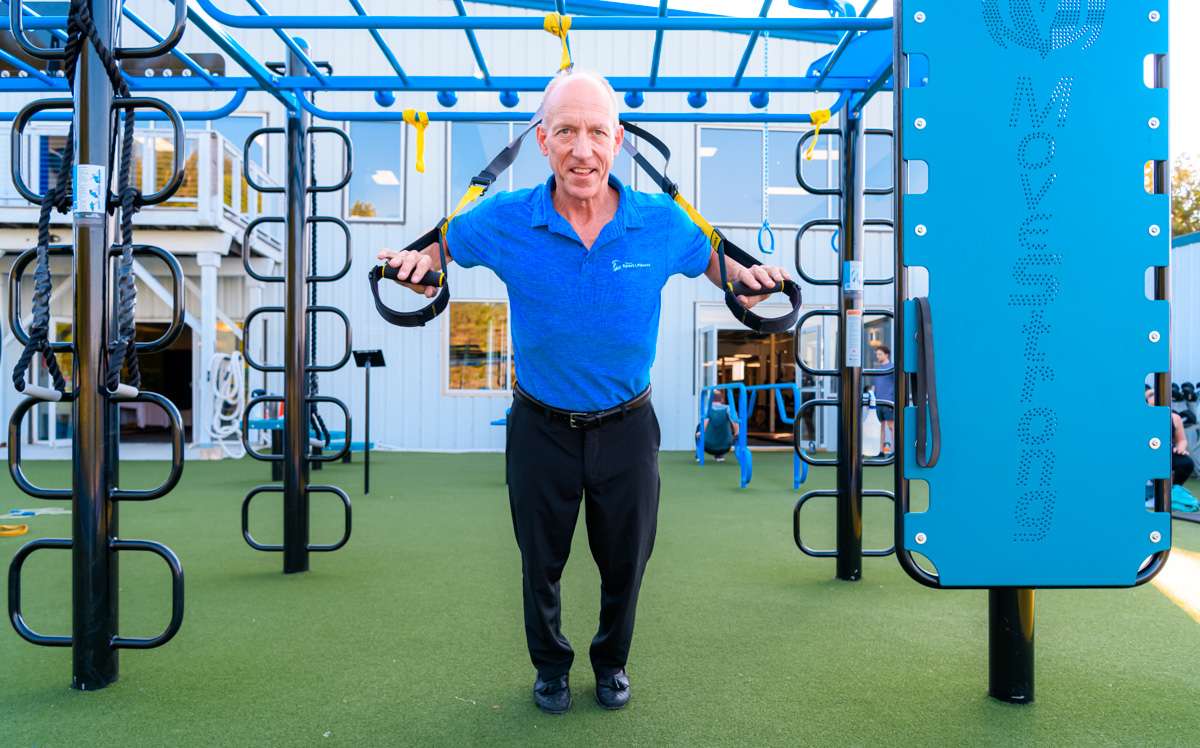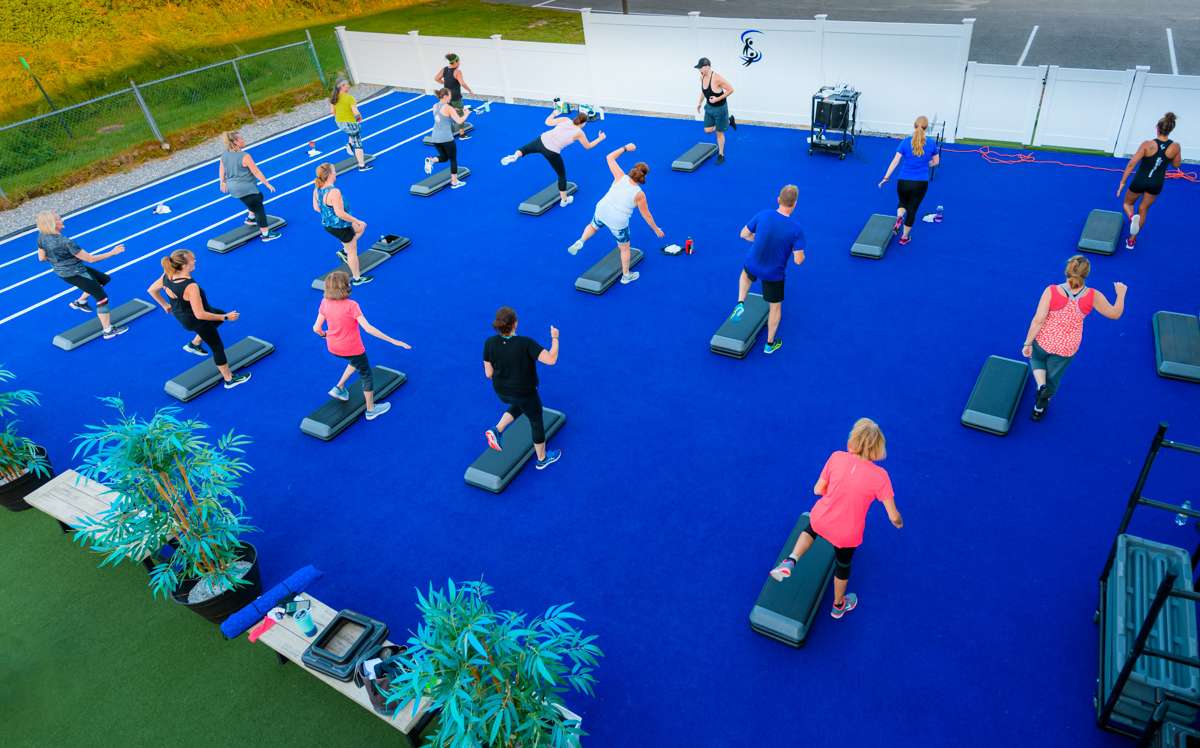
Survival of the fittest: Maine gyms, exercise industry regroup after pandemic pounding
 Photo / Tim Greenway
Julie Marchese and her daughter Paige Ferguson, co-owners of CycleBar, in the CycleTheatre at their Portland business.
Photo / Tim Greenway
Julie Marchese and her daughter Paige Ferguson, co-owners of CycleBar, in the CycleTheatre at their Portland business.
At 6 a.m. one morning at Portland’s CycleBar spinning studio, instructor Paige Ferguson peppers her Empower class with motivational messages.
“Are we ready to go? Let’s do this!” Ferguson tells a dozen cyclers as she activates the lights and music, starting with Yula’s “Something More,” in the darkened room. “Today we focus on going a little further, finding something new.”
CycleBar aims to do just that, after a tumultuous first year in business in one of the country’s most pandemic-stricken industries. Ferguson and her mother, Julie Marchese, opened their CycleBar franchise in September 2019.
Forced to close to the public for three months in 2020, the duo rented out bikes for home use and offered recorded and livestreamed classes. While that kept them in business, they lost about half their 600 members.
“It hasn’t been easy, but if we’ve learned one thing from the pandemic, it’s just to keep moving forward, says Ferguson, a college entrepreneurship major who moved back to Maine to embark on her first business venture with her mom. Marchese says she hopes the experience will make them stronger, adding that “even though the struggle has been hard, we still have the passion for what we’re doing.”

$20B in lost revenue last year
In 2019 when CycleBar opened, 40,000 fitness clubs nationwide — 80% of which were small businesses — employed 3 million people catering to 73 million gym-goers. After a decade of growth, revenues reached a record $35 billion in 2019, according to the Boston-based International Health, Racquet and Sportsclub Association, or IHRSA.
Then COVID hit, forcing facilities to close for an average of two to five months depending on the state and leading to $20 billion in lost revenue in 2020.
The fallout is far-reaching, with 1.5 million gym employees, personal trainers and operators — equal to 47% of the industry’s workforce — losing their jobs and 22% of facilities out of business as of July 1, 2021, based on data from the industry’s top 11 billing agencies. Studios, smaller than gyms and usually with a single focus, were hit the hardest, with 27% permanently closed.
While there’s no breakdown by state, COVID’s impact on fitness businesses reflected the length of each state’s mandatory closures and the severity of restrictions upon reopening — putting California at the greatest disadvantage and Maine somewhere in the middle. Regardless of state, however, gyms in downtown areas near offices are struggling the most.
In Maine where fitness clubs were allowed to reopen after three months, many didn’t survive while others scrambled to stay afloat by offering remote and outdoor options or by reducing prices. As those still in business grapple with lingering uncertainty over when the pandemic will end, many are seeking to get back to where they were pre-COVID — and in some cases even beyond. How they’ll fare remains to be seen.
Helen Durkin, a lawyer who serves as IHRSA’s executive vice president for public affairs, says that while it’s good that people are returning to gyms, the evolving upturn won’t make up for all the fixed costs such as rent that fitness club owners had to pay when shut down.
“If you have the cash flow, then you can weather the ups and downs coming with Delta and other variants,” she says. “The problem is, do you have enough cash to be bullish about the future? That’s the concern of a lot of small operators.”
Stepping outside the box
Among Maine fitness businesses that shifted gears during the pandemic, Saco Sport & Fitness — at 25,000 square feet, one of Maine’s largest — made big changes inside and outside.
Upgrades include turning an indoor spinning studio into an on-demand training room with cardio machines and taking all group classes virtually about two weeks into the shutdown.
This year’s main addition is a $250,000, 6,000-square-foot outdoor training area that opened in June for group classes, weight and functional training. Owner and general manager Scott Gillespie, who runs the club with his wife, Beth, built the outdoor area over a 30-year-old “tired-out pool” at what had been a racquet club back when he bought the property.
“It was an expensive investment, but we believe in improving the club every year and we feel that it was significant, worthwhile and timely,” Gillespie says.

The equipment, made by a company called Movestrong, includes embedded QR codes with links to instructional videos. There’s also an area for group classes. All sections were in use one recent evening, as cardio class participants stepped, squatted and sweated in a high-energy 60-minute class called Blast. It was also livestreamed via Zoom for any members wanting to participate from home.
Gillespie says the facility started offering livestreams two weeks into last year’s closure, initially from basements, garages and living rooms and then later from the club, which is also convenient for people when travelling or snowbirds who leave Maine during the winter. He also says that while the outdoor area is suitable for use year-round, including stainless steel weights that stay outside even at night, he expects that to wind down by around late October.
While Gillespie himself prefers functional training to lifting weights, one weight that still sits on his shoulders is the drop in members from 3,300 pre-COVID to around 2,500 today, and a reduction in staff from 70 to 50. A consultant to health clubs in numerous states on wellness programs and personal training, Gillespie has had a front seat to the industry’s woes during the pandemic and is a vocal champion for reversing the negative press about gym safety he believes was unfair.
He also supports securing long overdue federal relief for business owners, who had to rely on Paycheck Protection Program and other funding to tide them over but not industry-specific funding like there’s been for hospitality and live entertainment venues. “We believe we have been forgotten,” he says.
Smaller businesses also shifting
Smaller businesses also adapted. They include Wilcox Wellness & Fitness in Bangor, which did all-livestreaming for a while that owner Mike Wilcox says went “100 times better than I could have ever imagined.”
With trainers now up to speed in verbal coaching and the technology, virtual classes remain part of the mix along with in-person training and are “helping a lot of people,”he says. But there are currently fewer people to help, after the club lost about a third of its members during the pandemic.
“We weren’t expecting a big turnout,” Wilcox says, “but I think September and October will be a good sign, and hopefully everything with COVID doesn’t go the other way … Hopefully this whole thing is making people take their health and wellness more seriously and understand they have the power to take ownership of their health. We’re signing up new members all the time.”
U.S. Route 1 is also a beehive of activity for personal trainer Kellie Nichole, who has a studio inside the Patriot Insurance building in Yarmouth where she is rebranding to incorporate mental health into her wellness offering.
“I didn’t call myself a coach before, but I realized that’s where I shine and where I’m happier,” she says. “The pandemic has helped me have more confidence in my beliefs and meet people where they are.”
In Scarborough, Brayton Chase is getting ready to open Maniac Community Fitness in the Firehouse Village complex currently under development in a former fire and police station near the Town Hall. That’ll be his second gym after Maniac CrossFit, which started in Scarborough and relocated to South Portland. As business slowly starts to pick up, he believes this is a good time to expand and hopes to open by early November.
“There are days when I’m more nervous than excited, and days when I’m more excited than nervous,” he says.
Jibe Cycling Studio, in Portland and Yarmouth, is also spreading its wings with a third, out-of-state location, in Charleston, S.C., due to open in early 2022, after last year’s pandemic gut-punch. The two existing locations stayed afloat during the shutdown by renting out bikes for home use and offering outdoor classes, which was later discontinued due to staff shortages.
“Last year was really hard,” says owner Joanna Pease, “but we’re really optimistic that by the time November rolls around, we’ll be back up to our pre-pandemic numbers.”
Peloton vs. Planet Fitness
At the start of the pandemic when gyms nationwide shut down, business took off for interactive fitness platform Peloton and tanked for traditional gyms like Planet Fitness, the country’s second-leading franchise after Anytime Fitness with 2,124 clubs in 2020.
Stock prices reflected that, with Planet Fitness shares losing three-quarters of their value at the lowest point in March 2020. Peloton shares more than quadrupled last year and are still more than double the pre-pandemic price.
In Maine, where Planet Fitness has 11 locations from Biddeford to Bangor, Mike Cleary is an airline pilot-turned franchisee with five Planet Fitness sites, including a 28,000-square-foot South Portland site that opened in November 2020. More recently he expanded the Rockland location to 16,000 square feet inside a former J.C. Penney store, also adding new cardio machines as well as a functional training room and stretching area.
“When we reopened the door in Rockland after being closed for a day to install all the new equipment, there was a line out the door, and people were really excited,” says Cleary, who owns the franchises through Granite Coast Properties LLC in Portsmouth, N.H. “There was a real sense of community and a real sense of belonging.”
Cleary says that while Planet Fitness has always aimed for top cleanliness and friendly service, it doubled down on both in the wake of the pandemic while introducing other changes to make customers feel more comfortable. That includes a “Crowd Meter” on the Planet Fitness app that allows members to schedule visits when social distancing is easier.
“Last summer when we reopened as a brand, we developed a 97-page reopening playbook that all franchises used to make sure we were doing everything we could to keep team members and customers safe,” Cleary says as he eyes additional locations in Maine.
“We have some growth opportunities in mind around the state, so we’re pursuing those very actively,” he says.

Changing the narrative
Whether gym owners are in expansion or survival mode, uncertainty remains a common theme as the Boston-based IHRSA lobbies on behalf of a federal relief bill called the Gym Mitigation and Survival Act of 2021, often referred to as the GYMS Act. Durkin estimates the bill has well over 150 sponsors in the House and 23 in the Senate. Even with that support, she predicts an uphill battle in Congress “because I think they hoped that by this time no one needed any help.”
Working hard to change that narrative, Scott Gillespie of Saco Sport & Fitness says he’s cautiously optimistic that industry growth will return by the first quarter of next year. After all, he’s navigated tough times before, like rebuilding his club after it was destroyed by arson in 1994. “Lessons through that fire served me well through the pandemic,” he says.










0 Comments